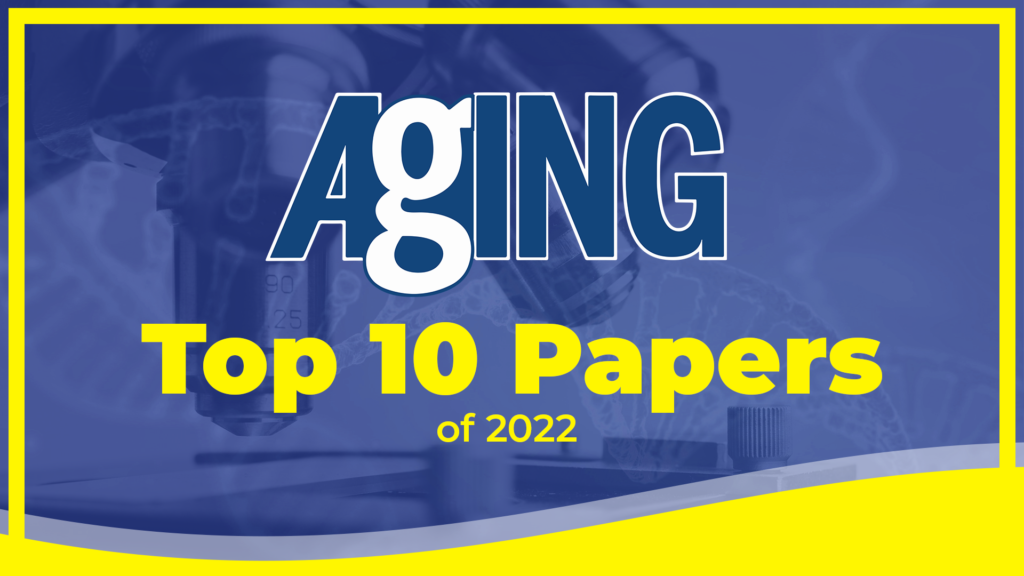Crossref is a non-profit organization that logs and updates citations for scientific publications. Each month, Crossref identifies a list of the most popular Aging (Aging-US) papers based on the number of times a DOI is successfully resolved.
Below are Crossref’s Top 10 Aging DOIs in 2022.
#10: DNA- and telomere-damage does not limit lifespan: evidence from rapamycin
DOI: https://doi.org/10.18632/aging.202674
Author: Mikhail V. Blagosklonny
Institution: Roswell Park Cancer Institute
Quote: “Failure of rapamycin to extend lifespan in DNA repair mutant and telomerase-knockout mice, while extending lifespan in normal mice, indicates that neither DNA damage nor telomere shortening limits normal lifespan or causes normal aging.”
DOI: https://doi.org/10.18632/aging.204264
Authors: Fedor Galkin, Kirill Kochetov, Diana Koldasbayeva, Manuel Faria, Helene H. Fung, Amber X. Chen, and Alex Zhavoronkov
Institutions: Deep Longevity Limited, Stanford University, The Chinese University of Hong Kong, Insilico Medicine, and Buck Institute for Research on Aging
Quote: “We have developed a deep learning aging clock using blood test data from the China Health and Retirement Longitudinal Study, which has a mean absolute error of 5.68 years. We used the aging clock to demonstrate the connection between the physical and psychological aspects of aging. The clock detects accelerated aging in people with heart, liver, and lung conditions.”
#8: DNA methylation GrimAge strongly predicts lifespan and healthspan
DOI: https://doi.org/10.18632/aging.101684
Authors: Ake T. Lu, Austin Quach, James G. Wilson, Alex P. Reiner, Abraham Aviv, Kenneth Raj, Lifang Hou, Andrea A. Baccarelli, Yun Li, James D. Stewart, Eric A. Whitsel, Themistocles L. Assimes, Luigi Ferrucci, and Steve Horvath
Institutions: University of California Los Angeles, University of Mississippi Medical Center, Fred Hutchinson Cancer Research Center, Rutgers State University of New Jersey, Public Health England, Northwestern University Feinberg School of Medicine, Columbia University Mailman School of Public Health, University of North Carolina, Chapel Hill, Stanford University School of Medicine, VA Palo Alto Health Care System, and National Institutes of Health
Quote: “We coin this DNAm-based biomarker of mortality “DNAm GrimAge” because high values are grim news, with regards to mortality/morbidity risk. Our comprehensive studies demonstrate that DNAm GrimAge stands out when it comes to associations with age-related conditions, clinical biomarkers, and computed tomography data.”
DOI: https://doi.org/10.18632/aging.203960
Authors: Frank W. Pun, Geoffrey Ho Duen Leung, Hoi Wing Leung, Bonnie Hei Man Liu, Xi Long, Ivan V. Ozerov, Ju Wang, Feng Ren, Alexander Aliper, Evgeny Izumchenko, Alexey Moskalev, João Pedro de Magalhães, and Alex Zhavoronkov
Institutions: Insilico Medicine Hong Kong Ltd., University of Chicago, George Mason University (GMU), University of Liverpool, and Buck Institute for Research on Aging
Quote: “In this study, we used a variety of target identification and prioritization techniques offered by the AI-powered PandaOmics platform, to propose a list of promising novel aging-associated targets that may be used for drug discovery. We also propose a list of more classical targets that may be used for drug repurposing within each hallmark of aging.”
DOI: https://doi.org/10.18632/aging.102580
Authors: Junqi Liu, Nannan Xue, Yuexin Guo, Kerun Niu, Liang Gao, Song Zhang, Hao Gu, Xin Wang, Di Zhao, and Ruitai Fan
Institutions: The First Affiliated Hospital of Zhengzhou University, German Cancer Research Center (DKFZ) and Saarland University Medical Center
Quote: “Circular RNAs (circRNAs) play important roles in regulating the radioresistance of esophageal squamous cell carcinoma (ESCC). This study aimed to determine the role of hsa_circRNA_100367 in regulating radioresistance of ESCC.”
DOI: https://doi.org/10.18632/aging.203843
Authors: Anette Arild, Torgil Vangberg, Hanne Nikkels, Stian Lydersen, Ulrik Wisløff, Dorthe Stensvold, and Asta K. Håberg
Institutions: NTNU Norwegian University of Science and Technology, UiT The Arctic University of Norway, University Hospital of North Norway, and Trondheim University Hospital
Quote: “We investigated if a five-year supervised exercise intervention with moderate-intensity continuous training (MICT) or high-intensity interval training (HIIT) versus control; physical activity according to national guidelines, attenuated the growth of white matter hyperintensities (WMH). We hypothesized that supervised exercise, in particular HIIT, reduced WMH growth.”
#4: The aging-related risk signature in colorectal cancer
DOI: https://doi.org/10.18632/aging.202589
Authors: Taohua Yue, Shanwen Chen, Jing Zhu, Shihao Guo, Zhihao Huang, Pengyuan Wang, Shuai Zuo, and Yucun Liu
Institution: Peking University
Quote: “Colorectal cancer (CRC) is the third most common cancer worldwide. The opening of the TCGA and GEO databases has promoted the progress of CRC prognostic assessment, while the aging-related risk signature has never been mentioned. R software packages, GSEA software, Venn diagram, Metascape, STRING, Cytoscape, cBioPortal, TIMER and GeneMANIA website were used in this study.”
#3: An epigenetic biomarker of aging for lifespan and healthspan
DOI: https://doi.org/10.18632/aging.101414
Authors: Morgan E. Levine, Ake T. Lu, Austin Quach, Brian H. Chen, Themistocles L. Assimes, Stefania Bandinelli, Lifang Hou, Andrea A. Baccarelli, James D. Stewart, Yun Li, Eric A. Whitsel, James G Wilson, Alex P Reiner, Abraham Aviv, Kurt Lohman, Yongmei Liu, Luigi Ferrucci, and Steve Horvath
Institutions: University of California Los Angeles, National Institutes of Health, Stanford University School of Medicine, Azienda Toscana Centro, Northwestern University Feinberg School of Medicine, Columbia University Mailman School of Public Health, University of North Carolina, Chapel Hill, University of Mississippi Medical Center, Fred Hutchinson Cancer Research Center, Rutgers State University of New Jersey, and Wake Forrest School of Medicine
Quote: “Identifying reliable biomarkers of aging is a major goal in geroscience. While the first generation of epigenetic biomarkers of aging were developed using chronological age as a surrogate for biological age, we hypothesized that incorporation of composite clinical measures of phenotypic age that capture differences in lifespan and healthspan may identify novel CpGs and facilitate the development of a more powerful epigenetic biomarker of aging.”
DOI: https://doi.org/10.18632/aging.103378
Authors: Hui Dong, Zhuanzhuan Qiang, Dongdong Chai, Jiali Peng, Yangyang Xia, Rong Hu, and Hong Jiang
Institution: Shanghai JiaoTong University School of Medicine
Quote: “Acute lung injury (ALI) is a syndrome associated with a high mortality rate. Nrf2 is a key regulator of intracellular oxidation homeostasis that plays a pivotal role in controlling lipid peroxidation, which is closely related to the process of ferroptosis. However, the intrinsic effect of Nrf2 on ferroptosis remains to be investigated in ALI.”
DOI: https://doi.org/10.18632/aging.204061
Authors: Fedor Galkin, Kirill Kochetov, Michelle Keller, Alex Zhavoronkov, and Nancy Etcoff
Institutions: Deep Longevity Limited, Insilico Medicine, Buck Institute for Research on Aging, and Harvard Medical School
Quote: “In this article, we present a deep learning model of human psychology that can predict one’s current age and future well-being. We used the model to demonstrate that one’s baseline well-being is not the determining factor of future well-being, as posited by hedonic treadmill theory. Further, we have created a 2D map of human psychotypes and identified the regions that are most vulnerable to depression. This map may be used to provide personalized recommendations for maximizing one’s future well-being.”
Click here to read the latest papers published by Aging.
AGING (AGING-US) VIDEOS: YouTube | LabTube | Aging-US.com
—
Aging is an open-access, peer-reviewed journal that has published high-impact research papers in all fields of aging research since 2009. These papers are available to readers (at no cost and free of subscription barriers) in bi-monthly issues at Aging-US.com.
For media inquiries, please contact [email protected].

